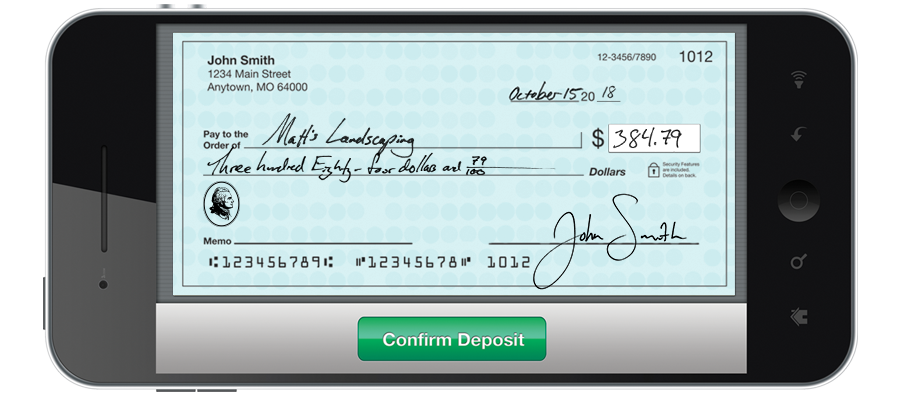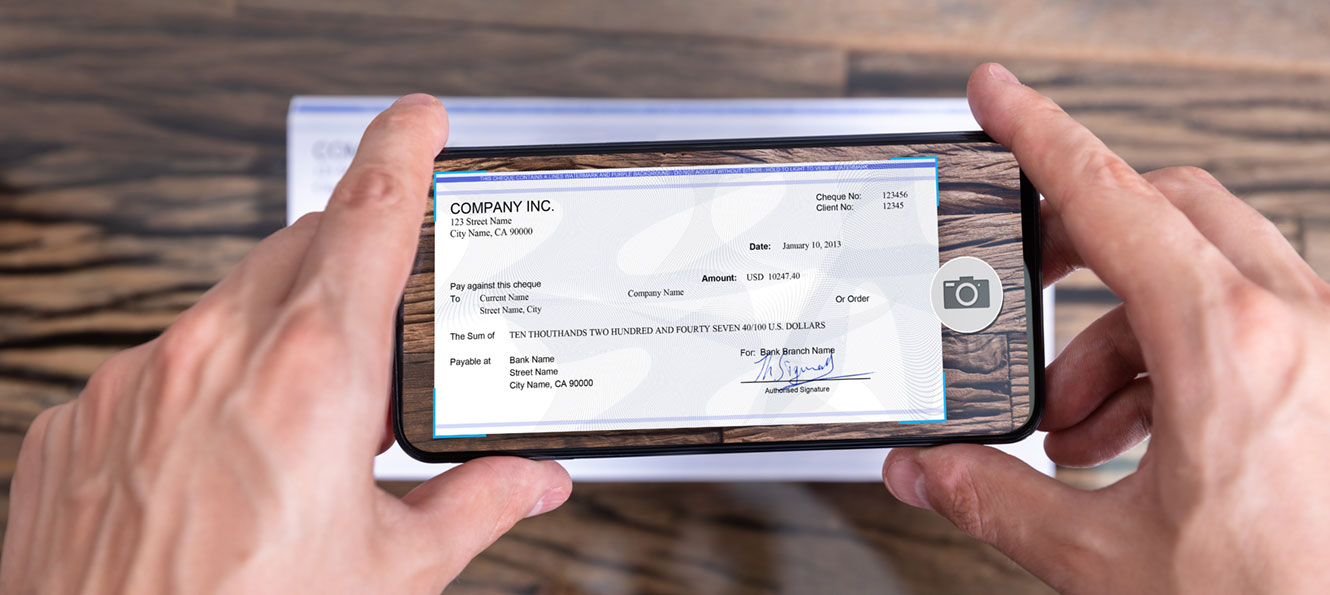Check Deposit 6,2/10 8345 votes
In a fake check scam, a person you don’t know asks you to deposit a check— sometimes for several thousand dollars, and usually for more than you are owed — and send some of the money to another person. The scammers always have a good story to explain why you can’t keep all the money. They might say they need you to cover taxes or fees, you’ll need to buy supplies, or something else.
With Chase QuickDeposit, our remote deposit solution, you just scan your paper checks and send the scanned images electronically or through mobile deposit to Chase for deposit into your checking. Tap Deposit a check and you'll be guided through the process of submitting a deposit for review. Once the deposit is submitted, we'll review it and send you a support message. You can submit a check or money order with our iOS and Android apps. Sign the back of the check and write “for deposit only at Bank of America”. Take photos of the front and back of the check with your smartphone — just select the Front of Check and Back of Check buttons.
Fake checks come in many forms. They might look like business or personal checks, cashier’s checks, money orders, or a check delivered electronically. Here’s what you need to know about fake check scams.
Types of Fake Checks Scams
Fake checks are used in many types of scams. Here are some examples:
- Mystery shopping. Scammers pretend to hire people as mystery shoppers and tell them their first assignment is to evaluate a retailer that sells gift cards, money orders, or a money transfer service, like Western Union or MoneyGram. The shopper gets a check with instructions to deposit it in a personal bank account and wire it to someone else. But once the money is wired, the person on the other end can disappear.
- Personal assistants. People apply online and get hired as personal assistants. They get a check and are told to use the money to buy gift cards or to buy equipment or supplies for their new client. Once the scammers get the gift card PIN numbers, they use them instantly, leaving the “personal assistant” without the money when the bank figures out the check is bad.
- Car wrap decals. People interested in car wrap advertising are told to deposit checks and send money to decal installers — who don’t exist.
- Claiming prizes. Sweepstakes “winners” are given checks and told to send money to cover taxes, shipping and handling charges, or processing fees. But that’s not how legitimate sweepstakes work.
- Overpayments.People buying something from you online “accidentally” send a check for too much and ask you to refund the balance.
Why Do These Scams Work?
These scams work because fake checks generally look just like real checks, even to bank employees. They are often printed with the names and addresses of legitimate financial institutions. They may even be real checks written on bank accounts that belong to identity theft victims. It can take weeks for a bank to figure out that the check is a fake.
Fake Checks and Your Bank


By law, banks have to make deposited funds available quickly, usually within two days. When the funds are made available in your account, the bank may say the check has “cleared,” but that doesn’t mean it’s a good check. Fake checks can take weeks to be discovered and untangled. By that time, the scammer has any money you sent, and you’re stuck paying the money back to the bank.
Your best bet: Don’t rely on money from a check unless you know and trust the person you’re dealing with.
How to Avoid a Fake Check Scam
- Never use money from a check to send gift cards, money orders, or wire money to strangers or someone you just met. Many scammers demand that you send money through money transfer services like Western Union or MoneyGram, or buy gift cards and send them the PIN numbers. Once you wire money, or give someone the gift card PINs, it is like giving someone cash. It’s almost impossible to get it back.
- Toss offers that ask you to pay for a prize. If it’s free, you shouldn’t have to pay to get it.
- Don’t accept a check for more than the selling price. You can bet it’s a scam.
What to Do If You Sent Money to a Scammer
Gift cards are for gifts, not payments. Anyone who demands payment by gift card is always a scammer. If you paid a scammer with a gift card, tell the company that issued the card right away. When you contact the company, tell them the gift card was used in a scam. Ask them if they can refund your money. If you act quickly enough, the company might be able to get your money back. Also, tell the store where you bought the gift card as soon as possible.

Here is a list of gift cards that scammers often use — with information to help report a scam. If the card you used is not on this list, you might find the gift card company’s contact information on the card itself, or you might need to do some research online.
If you wired money to a scammer, call the money transfer company immediately to report the fraud and file a complaint. You can reach the complaint department of MoneyGram at 1-800-MONEYGRAM (1-800-666-3947) or Western Union at 1-800-325-6000. Ask for the money transfer to be reversed. It’s unlikely to happen, but it’s important to ask.
If you paid a scammer with a money order, contact the company that issued the money order right away to see if you can stop payment. Also, try to stop delivery of the money order: if you sent it by U.S. mail, contact the U.S. Postal Inspection Service at 877-876-2455. Otherwise, contact whatever delivery service you used as soon as possible.
Where to Report Fraud
Check Deposit Link
If you think you’ve been targeted by a fake check scam, report it to:
- The Federal Trade Commission
- The U.S. Postal Inspection Service
- Your state Attorney General
Fake Check Scams Infographic
Depositing checks with your phone
- You can find the check deposit button in the navigation drawer of the Android app (tap Move Money, then Deposit a check).
- Tap that button, and you'll be guided through the process of submitting a deposit for review.
- Once the deposit is submitted, we'll review it and send you a support message.
- Swipe right to pull up the navigation menu.
- From there, tap Move Money.
- Tap Deposit a check and you'll be guided through the process of submitting a deposit for review.
- Once the deposit is submitted, we'll review it and send you a support message.
You can submit a check or money order with our iOS and Android apps. You'll see this option in the Move Money menu.
Things to keep in mind
- Whenever possible, submit your deposit before 5 p.m. ET (2 p.m. PT) on a business day. This ensures we'll be able to start processing it that day, making your funds available as quickly as possible.
- Since we'll be using your photo to create a legal copy of the deposit, make sure the image is clear and it includes all four corners of the deposit. Please don't write on the deposit or destroy it until we've confirmed it's been accepted.
- You can learn more about how a check or money order needs to be written and endorsed in the Deposit Requirements article.
Check Deposit Atm
How much can I deposit with Photo Check Deposit?
Your individual Photo Check Deposit limit can vary based on a few factors (like how long you've been with Simple, or how many checks you've deposited recently).
To find out your current limit:
- Check the mobile app. From the Move Money tab, tap Deposit a check to show your current limit.
- Talk to us! We'll let you know your current limit.
If you have a large check (yay!) that's over your limit, you can deposit it by mail.
When will my funds be available?
Generally, the funds will be available after 1 business day. If you submit a deposit before 5 p.m. ET (2 p.m. PT), we can start processing it that day. Accounts under 31 days old are subject to an extended hold of 9 business days.
You can get the full scoop in our article on check holds.
⇐ ⇐ Casino Demo Play
⇒ ⇒ Spin Samba